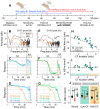This is a preprint.
Outer hair cells stir cochlear fluids
- PMID: 39149246
- PMCID: PMC11326228
- DOI: 10.1101/2024.08.07.607009
Outer hair cells stir cochlear fluids
Update in
-
Outer hair cells stir cochlear fluids.Elife. 2025 Jan 16;13:RP101943. doi: 10.7554/eLife.101943. Elife. 2025. PMID: 39817719 Free PMC article.
Abstract
We hypothesized that active outer hair cells drive cochlear fluid circulation. The hypothesis was tested by delivering the neurotoxin, kainic acid, to the intact round window of young gerbil cochleae while monitoring auditory responses in the cochlear nucleus. Sounds presented at a modest level significantly expedited kainic acid delivery. When outer-hair-cell motility was suppressed by salicylate, the facilitation effect was compromised. A low-frequency tone was more effective than broadband noise, especially for drug delivery to apical locations. Computational model simulations provided the physical basis for our observation, which incorporated solute diffusion, fluid advection, fluid-structure interaction, and outer-hair-cell motility. Active outer hair cells deformed the organ of Corti like a peristaltic tube to generate apically streaming flows along the tunnel of Corti and basally streaming flows along the scala tympani. Our measurements and simulations coherently suggest that active outer hair cells in the tail region of cochlear traveling waves drive cochlear fluid circulation.
Keywords: drug delivery; electromotility; kainic acid; organ of Corti; outer hair cell; perilymph.
Figures





Similar articles
-
Outer hair cells stir cochlear fluids.Elife. 2025 Jan 16;13:RP101943. doi: 10.7554/eLife.101943. Elife. 2025. PMID: 39817719 Free PMC article.
-
Consequences of Location-Dependent Organ of Corti Micro-Mechanics.PLoS One. 2015 Aug 28;10(8):e0133284. doi: 10.1371/journal.pone.0133284. eCollection 2015. PLoS One. 2015. PMID: 26317521 Free PMC article.
-
Amplification and Suppression of Traveling Waves along the Mouse Organ of Corti: Evidence for Spatial Variation in the Longitudinal Coupling of Outer Hair Cell-Generated Forces.J Neurosci. 2019 Mar 6;39(10):1805-1816. doi: 10.1523/JNEUROSCI.2608-18.2019. Epub 2019 Jan 16. J Neurosci. 2019. PMID: 30651330 Free PMC article.
-
The cochlear amplifier: augmentation of the traveling wave within the inner ear.Curr Opin Otolaryngol Head Neck Surg. 2004 Oct;12(5):431-8. doi: 10.1097/01.moo.0000134449.05454.82. Curr Opin Otolaryngol Head Neck Surg. 2004. PMID: 15377957 Free PMC article. Review.
-
Rectifying and sluggish: Outer hair cells as regulators rather than amplifiers.Hear Res. 2022 Sep 15;423:108367. doi: 10.1016/j.heares.2021.108367. Epub 2021 Oct 2. Hear Res. 2022. PMID: 34686384 Review.
References
-
- Berg H. C. (1993). Random walks in biology. Princeton, N.J., Princeton University Press.
Publication types
Grants and funding
LinkOut - more resources
Full Text Sources
